
3 月 . 08, 2024 10:34 Back to list
Energy storage systems (ESSs) play a crucial role in the electricity generation industry.
Energy storage systems (ESSs) play a crucial role in the electricity generation industry, offering a range of benefits to both the power sector and consumers. One major function of ESSs is balancing grid supply and demand while enhancing the quality and reliability of electricity. By storing energy, these systems can address fluctuations in supply and demand across different time scales, ensuring grid stability and optimal performance. Additionally, ESSs equipped with fast response capabilities are valuable for providing ancillary services to electric power grids, helping to maintain grid frequency in real-time and safeguarding against disruptions that can damage electrical equipment.
Another significant advantage of ESSs lies in their ability to shave peak electricity demand and capitalize on price arbitrage opportunities. By charging ESSs during periods of low electricity demand and discharging during peak times, consumers can flatten daily load shapes and reduce reliance on costly reserve generation capacity. This approach not only helps to lower wholesale electricity prices but also enables the selling of stored electricity at a premium, creating arbitrage opportunities that can improve cost-effectiveness and efficiency in energy management.
Moreover, energy storage systems are instrumental in storing and smoothing renewable electricity generation, particularly from intermittent sources like solar and wind energy. By pairing ESSs with renewable energy power plants, operators can optimize the utilization of these resources and respond to grid demands more effectively. Furthermore, ESSs facilitate the integration of off-grid renewable energy systems, allowing for greater flexibility in utilizing clean energy sources where grid access is limited or unavailable.
ESSs also offer the advantage of deferring investments in traditional electricity infrastructure, such as substations and transmission lines. By strategically deploying ESSs at key points on the grid, utilities can manage increased electricity demand more cost-effectively without the need for extensive infrastructure upgrades. This approach not only saves on capital expenditure but also enhances grid resilience and operational efficiency.

In addition to grid support functions, ESSs are valuable for providing backup power during grid outages, ensuring uninterrupted electricity supply for consumers. Furthermore, commercial and industrial users can leverage onsite energy storage to reduce their electricity demand and associated charges, thus optimizing their energy consumption and lowering operational costs. ESSs also play a key role in utility demand-side management programs, offering a flexible solution for mitigating peak demand and improving overall energy efficiency.
The integration of ESSs into microgrids represents another significant development in the energy storage landscape. Microgrid systems, serving localized areas or customer bases, can leverage ESSs to enhance grid resilience, optimize energy use, and enable greater autonomy from the main grid. Whether functioning in isolation or connected to the larger grid with automatic isolation capabilities, microgrid ESSs offer a versatile and sustainable approach to electricity storage and distribution.
ESSs are designed to cater to varying timescales, reflecting the differences in discharge-generation cycle lengths. They can be classified into two main categories based on duration and primary use: short duration systems, which operate on minutes scales and are power-oriented, and diurnal or daily duration systems, which function on hourly scales and are energy-oriented. Various ESS technologies, including pumped-hydro, compressed air, batteries, flywheels, and supercapacitors, contribute to meeting different operational requirements, from providing consistent electricity supply over extended periods to offering rapid response for managing grid fluctuations.
In conclusion, energy storage systems are versatile tools that offer a multitude of benefits across the electricity generation landscape. From grid balancing and peak demand management to renewable energy integration and infrastructure deferral, ESSs play a crucial role in enhancing grid stability, lowering costs, and promoting sustainable energy practices. As the energy industry continues to evolve towards a cleaner and more efficient future, the role of energy storage systems will only become more central in enabling a reliable and resilient electricity supply for generations to come.
-
Unraveling the Power of EMS Energy Management Systems
NewsOct.23,2024
-
Unleashing the Potential of Power System Management and Smart Energy Solutions
NewsOct.23,2024
-
Smart Energy Mastery: Unleashing the Power of Controls
NewsOct.23,2024
-
Smart Energy Management: Unleashing the Power of Energy Management Systems and BMS Energy
NewsOct.23,2024
-
Powering Progress: ADMS, Intelligent Management & More
NewsOct.23,2024
-
Energizing the Future: Devices, Smart Management & Savings
NewsOct.23,2024


